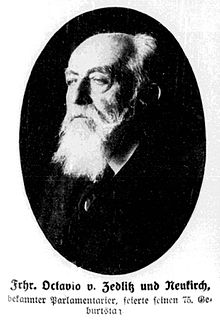Octavio von Zedlitz-Neukirch
Octavio Wilhelm Friedrich Otto Konrad Freiherr von Zedlitz-Neukirch (born December 6, 1840 in Glatz , Silesia Province , † March 31, 1919 in Berlin ) was a German politician, member of the Reichstag and member of the Prussian House of Representatives .
origin
His parents were the police chief of Berlin Constantin von Zedlitz-Neukirch (1813-1889) and his wife Charlotte von Falkenhausen-Trautskirchen (* 1817).
Life
Baron Octavio von Zedlitz-Neukirch attended high school in Glatz and then the Liegnitzer Knight Academy . After studying law at the Universities of Heidelberg , where he had become a member of the Corps Saxo-Borussia in 1859 , and Berlin , he entered the civil service in 1860 as a court trainee. In the German War of 1866 he was seriously wounded as a lieutenant in the 4th Hussar Regiment near Königgrätz . In 1867 he passed the assessor examination and in 1868 became district administrator of the Sagan district . During the Franco-Prussian War of 1870/1871 he was appointed sub-prefect of Saint-Quentin , after which he worked in the Reich Chancellery in 1874 . In 1876 he was appointed to the Ministry of Commerce and in 1881 as a lecturing councilor to the Ministry of Public Works. In 1899 he was promoted to President of Maritime Trade . In the same year he became President of the Prussian State Bank, but had to resign from this post after a short time because of his opposition to the Mittelland Canal .
In the years 1871 to 1874 he was a member of the Reichstag for the constituency of Liegnitz 2 (Sagan-Sprottau), from 1877 to 1918 for the Free Conservative Party member of the Prussian House of Representatives, after Wilhelm von Kardorff's death in 1907, parliamentary group chairman until April 1918. He was considered the “Gray eminence” of the party.
Octavio von Zedlitz-Neukirch died in Berlin in 1919 at the age of 78. He was buried in the Old Twelve Apostles Cemetery in Schöneberg . The grave has not been preserved.
family
On April 12, 1881, he married Henriette Frederike Anna Binseel (* November 15, 1840; † May 15, 1897), divorced Ernst Heinrich Theodor Neumann . Zedlitz adopted her two children, who were accepted into the Prussian nobility on April 28, 1889 under the name von Zedlitz :
- Viktor Siegismund Konstantin (born August 18, 1870) ∞ Magarethe Brandes
- Elisabeth Charlotte (born December 19, 1871)
Works
- Thirty years of Prussian finance and tax policy. Berlin 1901.
literature
- Memorable men from and in County Glatz. In: Leaflets for the history and local history of the County of Glatz. Issue 1, 1906, p. 29.
- Zedlitz-Neukirch . In: Meyers Konversations-Lexikon . 4th edition. Volume 16, Verlag des Bibliographisches Institut, Leipzig / Vienna 1885–1892, p. 840.
Individual evidence
- ^ Kösener corps lists 1910, 120 , 540.
- ↑ Volker Stalmann: The Conservative Parties (1867-1918). In: Lothar Gall (Ed.): Government, Parliament and the Public in the Age of Bismarck. Paderborn 2003.
- ^ Fritz Specht, Paul Schwabe: The Reichstag elections from 1867 to 1903. Statistics of the Reichstag elections together with the programs of the parties and a list of the elected representatives. 2nd Edition. Carl Heymann Verlag, Berlin 1904, p. 76.
- ↑ Bernhard Mann (edit.): Biographical manual for the Prussian House of Representatives. 1867-1918 . Collaboration with Martin Doerry , Cornelia Rauh and Thomas Kühne. Düsseldorf: Droste Verlag, 1988, p. 429. (Handbooks on the history of parliamentarism and political parties: Vol. 3)
- ^ Hans-Jürgen Mende: Lexicon of Berlin burial places . Pharus-Plan, Berlin 2018, ISBN 978-3-86514-206-1 , p. 758.
- ↑ Gothaisches genealogisches Taschenbuch der Briefadeligen houses 1917. Eleventh year, p. 978.
Web links
- Octavio von Zedlitz-Neukirch in the database of members of the Reichstag
| personal data | |
|---|---|
| SURNAME | Zedlitz-Neukirch, Octavio von |
| ALTERNATIVE NAMES | Zedlitz-Neukirch, Octavio Athanis from |
| BRIEF DESCRIPTION | German politician, MdR |
| DATE OF BIRTH | December 6, 1840 |
| PLACE OF BIRTH | Glatz , Province of Silesia |
| DATE OF DEATH | March 31, 1919 |
| Place of death | Berlin |
